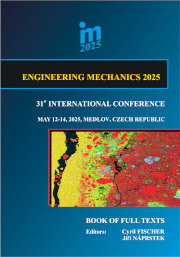Proceedings Vol. 31 (2025)

ENGINEERING MECHANICS 2025
May 12 – 14, 2025, Medlov, Czech Republic
All papers were reviewed by members of the scientific committee.
ISBN 978-80-86246-99-4 (electronic)
ISSN 1805-8248 (printed)
ISSN 1805-8256 (electronic)
scientific committee — home
Chapter 8: Reliability of Structures
An Experimental study of twelve bolted single-brace eccentric gusset plate connections in compression was carried out. Ten experiments were made of steel S355 and two experiments made of steel S690. The specimens varied also in their geometry, namely the geometry of the plate, namely the connection plate length, tapering, thickness, weld on one or two sides, and the slenderness of the connected member itself. The results were compared with the predictions of existing analytical models. The observed resistances demonstrate the influence of the plate slenderness on a compressive resistance of the connection. The influence of basic parameters of connection and the accuracy of existing design procedures is shown.
The paper focuses on the impact of fire-induced dynamic actions on structures, particularly material behavior at high temperatures and strain rates. The goal is to calibrate an induction heating system for tensile coupon tests to obtain material properties under dynamic loading. Previous studies on creep effects and strain rates in steel were reviewed. The research uses steady-state testing to assess the mechanical properties of steel under heating and loading conditions, ensuring a uniform temperature distribution within the specimen. Experimental results are combined with numerical simulations to predict temperature distribution and analyse the effects of different heating and loading rates on creep.
Operational load monitoring is essential for structural health assessment and possible fatigue failure prediction. In such processes strain sensors are usually used to capture localized deformations for precise load estimation. But, the monitoring accuracy depends on placement and orientation of the sensor. This study employed a numerical method to optimize strain sensor placement in 2D structures. The goal is to determine sensor location and orientation in order to capture maximal values of strain in the structure. Objective function was defined and genetic algorithm was implemented to find the global extremum of the function. The developed methodology and algorithms were tested with two structural examples of irregular geometry. In both cases the optimization algorithm converged to optimal sensor position. The results proved that the method can be used to improve measurement accuracy and cost efficiency for operational load monitoring processes.
The paper presents a part of research focused on the influence of cracks on the fire resistance of wooden structures and their potential integration into numerical models. The increasing interest in using wood as a sustainable construction material emphasizes the necessity of a detailed investigation of its behavior during fire exposure. Existing analyzed methods often rely on conservative charring rates under standard fire conditions, which are not remotely similar to natural fire conditions and at the same time do not describe the reality of the development of the charred layer and formation of cracks in the layer. A numerical model was developed to incorporate an equation for a more realistic charring rate based on a probabilistic approach and crack distances. This allowed the inclusion of the effect of anisotropic wood properties, moisture, density, and oxygen content, which led to a better description of the wooden structure’s behavior during fire exposure. Results of the model show good consistency of the prediction with the data measured during the experiment.
Copyright © 2025 Institute of Theoretical and Applied Mechanics, Czech Academy of Sciences, Prague
All contributions are published under the Creative Commons Attribution 4.0 International License (CC BY 4.0). The copyright remains with the authors. The texts are publicly accessible, and any reuse must include appropriate credit to the original source as required by the license.
